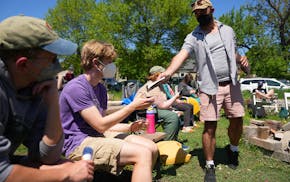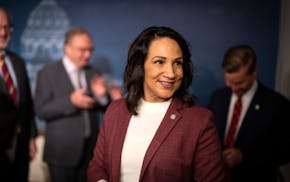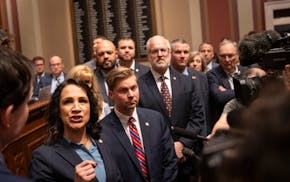Native American art decorates a student lounge at the University of Minnesota Medical School's Duluth campus, along with bundles of cedar and sweetgrass.
It's the school's Center of American Indian and Minority Health, a favorite spot for Native American medical students to take a break. Connecting with each other, many say, is invaluable to their education and ultimately improves the health of the Native population.
Since UMD's medical school opened in 1972, it's become one of the top producers of Native American med school graduates in the United States. Now UMD is believed to be the only school in the country to require eight hours of instruction on treating Native Americans. Dr. Mary Owen, the center's director and former president of the Association of American Indian Physicians, is encouraging other medical schools to adopt course requirements for Native American health education.
The number of Native Americans pursuing medical degrees hasn't changed in four decades, and it's not hard to see why, Owen said. While Minnesota's overall high school graduation rate is 83.8%, the Native graduation rate is 55.7%. Native Americans make up well under 1% of medical students nationwide, a number that doesn't reflect the 2% of U.S. citizens who are Native. UMD's incoming class this year enrolled five Indigenous students.
"We're doing our side, but where the hell is the U.S. government in educating Native people?" Owen said.
Current vacancy rates at Indian Health Services clinics and hospitals in the Duluth area are 46%, according to Owen. A 2018 federal Government Accountability Office report cited 25% vacancy rates across Indian Health Services nationally.
That's part of the inspiration behind the new course requirements at UMD, Owen said. Most doctors will take care of a Native patient at some point, she said, but it's hard to care for people appropriately without knowing anything about their culture.
"We have to educate whites on how to take care of us," she said.
The eight course hours incorporate how historical events affect Native people and touch on health disparities, care for people who have experienced trauma, and traditional medicine. The coursework will be incorporated in all U medical school curriculums as early as this fall.
Owen had never met a Native physician until she entered the UMD medical school in 1995, when Dr. Gerald Hill served as head of the center. It was a relief for Owen after years of "garbage jobs" in her native Alaska following college graduation. "We always had that kind of support, the validation that you're not crazy," she said.
After graduating from UMD and spending 11 years as a family doctor in her Tlingit community in Juneau, Alaska, Owen decided to return to Minnesota in 2013 to direct the center and make a greater impact on improving Native health outcomes.
'Why stop there?'
Cailean Dakota MacColl, a first-year medical student, stopped by the center before working with cadavers — honoring MacColl's mother's Cree and Métis teaching to wash one's face with medicine water in the presence of death.
Another first-year student, ZhaaZhaa Greensky, participated in a smudging ceremony offered by the center. "They had an elder come in and do a prayer," she said. "That was extremely helpful to me."
Greensky, 26, of Marble, Minn., remembers two moments pivotal in her decision to pursue medicine. When she was 8, she visited her grandmother in the hospital and repositioned a pillow to better support her leg. "I started to realize that I really liked taking care of people," she said.
A couple years later, a teacher challenged her when she said she wanted to be a nurse. "Why stop there?" the teacher said. "You could be a doctor."
After graduating from Michigan Tech, Greensky — who is Anishinaabe — was thrilled to find the community at the Duluth center. Putting cedar in her shoes and sage next to her heart, and having a Native classmate to check in with, made the difference, she said.
Now her dream is to practice family medicine on the Fond du Lac Reservation near Cloquet.
"To be able to help my community in a way that wasn't available to my grandma, sister and father — that is what gets me through the end of the day," Greensky said.
MacColl, 29, grew up in Oregon with a "savant-level smart" surgeon dad and remembers running around the hospital where he worked. One of MacColl's grandmothers nursed men with chainsaw injuries in her kitchen, while another served her Cree community as a traditional medicine woman.
When an older sister got sick, MacColl became her caretaker. It was humbling, but MacColl had a knack for it: "My ancestors were calling me back to that healing space."
MacColl looked for a medical school that would blend a modern career with traditional cultural practices, and said that interviewing with Owen "was like talking to an auntie."
"We're really traditional people, but we have really nontraditional stories, and this school gave us the chance to be ourselves," MacColl said. "The more people who can see themselves as people in white coats, that's how we live representation."
This story comes to you from Sahan Journal, a nonprofit newsroom dedicated to covering Minnesota's immigrants and communities of color. Sign up for a free newsletter to receive Sahan's stories in your inbox.

Want to share info with the Star Tribune? How to do it securely

'Safe recovery sites' would offer syringes, naloxone and more to people using drugs. The plan could be in peril.
New Minnesota GOP leaders seek peace with party's anti-establishment wing

Who is Republican Lisa Demuth, Minnesota's first House speaker of color?

